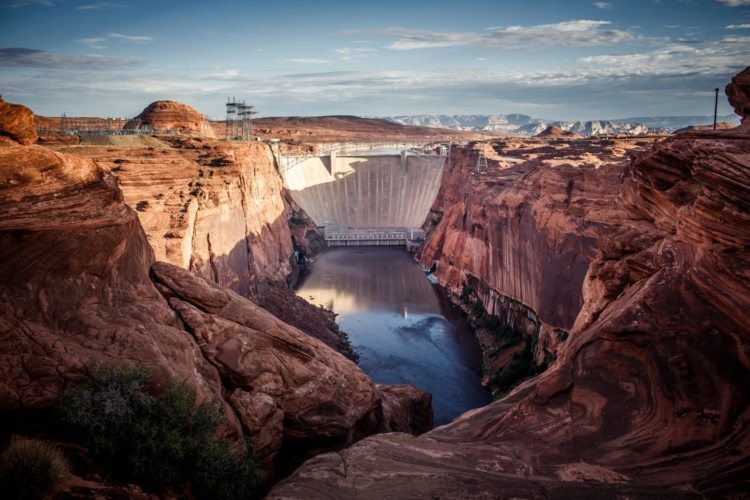Water, energy and real estate development are all interconnected and dependent on each other like three legs of a tripod. If one leg falters, the other two soon follow.
Valley Partnership’s mission in advocating for responsible development coincides with advocacy for the responsible management, delivery and advancement of Arizona’s water and energy resources because one cannot exist without the others.
For that reason and more, Valley Partnership has collaborated with the state’s top producers of water and energy for years now on ways to make better use of both in order to support the continued growth, development and prosperity of Arizona and its metro areas.
While Arizona Public Service Electric Company (APS), Central Arizona Project (CAP) and Salt River Project (SRP) all play critical roles in maintaining the quantity and reliability of Arizona’s water and energy in order to support continued development, Valley Partnership plays an important role in spreading awareness and educating the public and businesses about how water and energy issues affect them as well as ways to get involved.
Water: Learning to live with less
Arizona is known for being a responsible steward of its water supply, which has other states turning to Arizona for policy ideas, innovations and best practices.
For instance, the passing of the historic 1980 Groundwater Management Act, the first of its kind in the nation, set restrictions on pumping the state’s groundwater and developed conservation goals.
 Despite Arizona’s proactive, forward-thinking practices and policies, the state is still plagued by an 18-year drought in the Colorado River Basin and the over allocation of Lake Mead to California, Nevada and Mexico by 1.2 million-acre-feet per year.
Despite Arizona’s proactive, forward-thinking practices and policies, the state is still plagued by an 18-year drought in the Colorado River Basin and the over allocation of Lake Mead to California, Nevada and Mexico by 1.2 million-acre-feet per year.
Ted Cooke, general manager at CAP, describes the current state of Arizona’s water supply as an imbalance and not a crisis, but he warns it will become one if we do nothing.
“We have to learn to live with a little bit less and we need to do that in an agreed to and managed way ahead of time rather than react to a crisis,” he explains. “We have to work together to conserve and learn to deal with having less of a supply so we can keep the value of what we have.”
This requires a two-pronged approach that looks at conservation measures and longer term supply solutions like desalination, cloud seeding, more efficient water reclamation and underground storage facilities.
It also includes the Governor’s Water Augmentation Council, which was established to look at additional water conservation and augmentation strategies because of rising concerns about declining groundwater levels.
This created 22 planning areas around the state designed to coalesce areas with common problems and the potential ability to create common solutions, says the Council’s Chairman Tom Buschatske, director of Arizona Department of Water Resources.
He explains, “The idea with the planning areas is to work with stakeholders, educate them and update our water use information to build up a consensus base of solutions that may be implementable through new policy or legislation.”
To represent the real estate development industry, Gov. Doug Ducey appointed Cheryl Lombard, president and CEO of Valley Partnership, to the Council.
Energy: Powering the future
While energy may not get as much attention as water issues in the desert, it is equally important to supporting real estate development, the daily routines of residents and operations of businesses.
 Gretchen Kitchel, executive analyst for economic development at SRP, says, an innumerable number of companies are interested in locating to Arizona, especially data centers, because Arizona is natural disaster free and SRP is top-five in the nation for reliable power delivery.
Gretchen Kitchel, executive analyst for economic development at SRP, says, an innumerable number of companies are interested in locating to Arizona, especially data centers, because Arizona is natural disaster free and SRP is top-five in the nation for reliable power delivery.
Right now, she explains, “We have a big evolution of technological advancements in energy.” She likens it to landlines moving to cellphones in terms of the innovative tech causing major disruptions.
For example, in August 2015, SRP and BASELAYER unveiled the first SRP DataStation modular data center at SRP’s Corbell Substation in Gilbert. The first of its kind in the world, these DataStations will provide an innovative approach to supporting the addition of critical data centers in the Phoenix Metro area through making them more efficient and less expensive.
Kitchel says, “We have countless numbers of other people interested and fascinated with it because it’s a big technological change in how we do data centers,” including the United States Department of Energy.
Between new technology that allows people to self-generate energy and efforts to create a battery storage system to power a home, Kitchel foresees another big leap forward in the energy sector through new innovations and disruptions.
“Everybody thinks utility companies are older, but we like to think of ourselves as quite innovative,” Kitchel says. “Our data center stations are an example as to how we are looking to remain on the cutting edge of innovation.”




